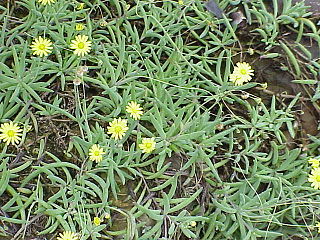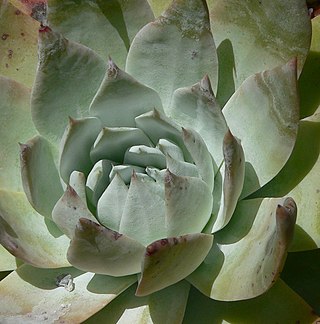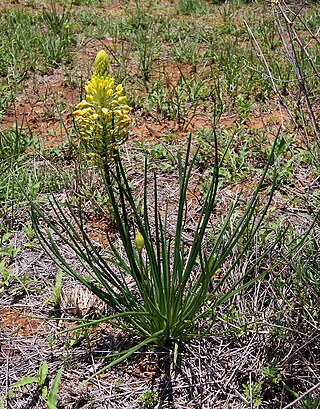
Asphodeloideae is a subfamily of the monocot family Asphodelaceae in the order Asparagales. It has previously been treated as a separate family, Asphodelaceae sensu stricto. The family Asphodelaceae has now been proposed to be a nomen conservandum, and the proposal has been recommended for ratification in 2017. In that case, Asphodelaceae will have priority over Xanthorrhoeaceae. This is reflected in the APG IV family lists.

Echinopsis is a large genus of cacti native to South America, sometimes known as hedgehog cactus, sea-urchin cactus or Easter lily cactus. One small species, E. chamaecereus, is known as the peanut cactus. The 128 species range from large and treelike types to small globose cacti. The name derives from echinos hedgehog or sea urchin, and opsis appearance, a reference to these plants' dense coverings of spines.

Bergerocactus emoryi is a species of cactus, known commonly as the golden-spined cereus, golden snake cactus, velvet cactus or golden club cactus. It is a relatively small cactus, but it can form dense thickets or colonies, with the dense yellow spines giving off a velvety appearance when backlit by the sun. From April to May, yellow, green-tinged flowers emerge, which transform into reddish, globular fruit. This species is native to the California Floristic Province, and is found in northwestern Baja California and a small part of California, in San Diego County and on the southern Channel Islands. Where the Mediterranean climate of the California Floristic Province collides with the subtropical Sonoran Desert near El Rosario, hybrids with two other species of cacti are found. It is the sole member of the monotypic genus Bergerocactus, named after German botanist Alwin Berger.

Bulbine bulbosa, commonly known as bulbine lily, native leek, golden lily, or native onion, is a species of flowering plant in the family Asphodelaceae and is endemic to Australia. It is a perennial herb with thick roots, channelled leaves, and yellow flowers with hairy stamen filaments.

Bulbine is a genus of plants in the family Asphodelaceae and subfamily Asphodeloideae, named for the bulb-shaped tuber of many species. It was formerly placed in the Liliaceae. It is found chiefly in Southern Africa, with a few species extending into tropical Africa and a few others in Australia and Yemen.

Crassothonna capensis, also known as little pickles (USA), ruby necklace (Australia), Cape aster, Cape Othonna, and Bobbejaankool (Afrikaans), is a species of the genus Crassothonna previously (Othonna) in the family Asteraceae, and is a native of the Eastern Cape of South Africa. It is a native highveld species that originates from the southern Drakensberg region.

In botany, succulent plants, also known as succulents, are plants with parts that are thickened, fleshy, and engorged, usually to retain water in arid climates or soil conditions. The word succulent comes from the Latin word sucus, meaning "juice" or "sap".

The peyote is a small, spineless cactus which contains psychoactive alkaloids, particularly mescaline. Peyote is a Spanish word derived from the Nahuatl peyōtl, meaning "caterpillar cocoon", from a root peyōni, "to glisten". Peyote is native to Mexico and southwestern Texas. It is found primarily in the Sierra Madre Occidental, the Chihuahuan Desert and in the states of Nayarit, Coahuila, Nuevo León, Tamaulipas, and San Luis Potosí among scrub. It flowers from March to May, and sometimes as late as September. The flowers are pink, with thigmotactic anthers.

A cactarium or cactuario is a garden dedicated to the planting of cacti. While they generally specialize in collecting cacti, they can also include other desert plants such as sabla, agaves or Crassulaceae, although this would better be termed "xeriscaping".

Echinocactus horizonthalonius is a species of cactus known by several common names, including devilshead, turk's head cactus, blue barrel cactus, eagle's claw, horse maimer, horse crippler, and visnaga meloncillo. It is native to the southwestern United States and northern Mexico, where it occurs in Chihuahuan Desert and Sonoran Desert habitats, particularly on limestone substrates. One of its varieties is a federally listed endangered species of the United States.

Echeveria runyonii is a species of flowering plant in the family Crassulaceae, that is native to the state of Tamaulipas in Mexico. Several cultivars have been described and cultivated.
Lucretia Breazeale Hamilton (1908–1986) was an American botanical illustrator, who was considered an expert on southwestern United States flora. She illustrated numerous technical papers for the University of Arizona and 16 books. She was posthumously recognized with a Desert Willow cultivar named in her honor and induction into the Arizona Women's Hall of Fame.

Bulbine cepacea is a flowering plant in the genus Bulbine, endemic to the Western Cape province, South Africa.
Bulbine bruynsii is a species of plant in the genus Bulbine. It is endemic to South Africa.

Dudleya anthonyi, known by the common name San Quintín liveforever, is a succulent plant endemic to the San Quintín volcanic field, located on Isla San Martín and the adjacent mainland bay of Bahia San Quintín, within Baja California.

Bulbine abyssinica is a species of plant in the genus Bulbine, from eastern and southern Africa.
Conophytum chrisolum is a species of succulent plant in the family Aizoaceae. It is endemic to the Richtersveld region of Northern Cape Province in South Africa. It may be the smallest free-living, land dwelling (non-aquatic) flowering plant, and certainly is the smallest succulent, measuring no more than 0.4 inch (10 mm) in height by less than 0.25 inch (6 mm) in width. It never branches or divides. It was only discovered in 1994 by botanical explorer Chris Rodgerson. The solitary magenta colored flower, up to 0.8 inch (20 mm) in diameter, is wider than the plant.
Euphorbia marie-cladieae, is a species of flowering plant in the spurge family Euphorbiaceae. It is endemic to Socotra, Yemen, where it is found in western tip of the island.
Euphorbia momccoyae is a species of flowering plant in the family Euphorbiaceae. It is a succulent shrub found in the Dhofar Governorate, Oman, and the Hadhramaut Governorate, Yemen.
Aloe djiboutiensis is a species of aloe native to Djibouti and Eritrea. It was first described in 2007 in the CSSA Journal by T. A. McCoy.













